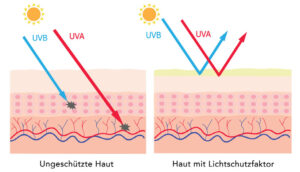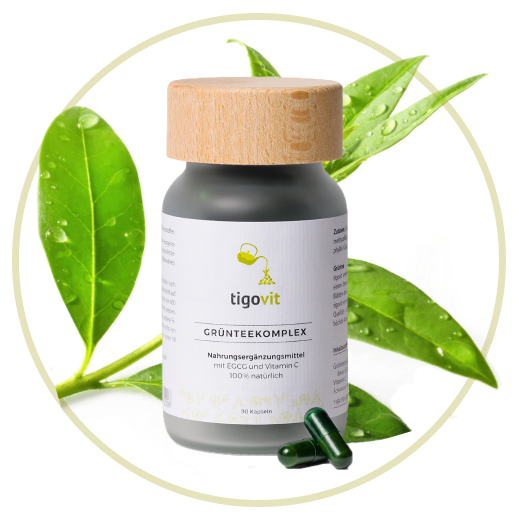Clearly, sunscreen on the skin is essential when sunbathing, whether on holiday or at home. Too much sun for unprotected skin means sunburn, increased risk of skin cancer and premature ageing of the skin. But what is actually contained in conventional sun creams? How healthy is it to put on a sunscreen with high UV protection and then spend hours sunbathing? What can I do to get my sun tan in a skin-friendly way?
In any case, a healthy combination is mindful sunbathing (sun hat, shade, light clothing, no blazing midday sun) and a sun cream with certain plant oils and a natural mineral filter. This way, one does not get into the decision-making dilemma between protection against harmful UV radiation from sun creams with a high sun protection factor and the potential risks of the substances they contain for health and the environment.
This blog article shows which chemical substances are used as sunscreens in industrial sunscreens, what damage they can do to the body and the environment, what the difference is between physical and chemical sun protection, how the sun protection factor affects the sun protection and which plant oils and extracts with natural sun protection factor (SPF) and with antioxidant protection in the natural pharmacy are an ideal alternative.
No more sunburn: antioxidants and natural plant oils with SPF
 Plants need to protect themselves from the intense UV radiation without a sun hat and escape into the shade, which is why they produce substances that form natural filters and provide a High antioxidant protection against free radicals offer. There is therefore an enormous range of natural plant oils and secondary plant substances that can be used effectively as UV blockers and as effective antioxidants in the skin cells. Rice oil, jojoba oil, carrot seed oil and argan oil, among others, contain a natural sun protection factor. In addition, certain plant extracts and the antioxidants vitamin C and E promote the antioxidant capacity of the skin cells and thus the protection against free radicals.
Plants need to protect themselves from the intense UV radiation without a sun hat and escape into the shade, which is why they produce substances that form natural filters and provide a High antioxidant protection against free radicals offer. There is therefore an enormous range of natural plant oils and secondary plant substances that can be used effectively as UV blockers and as effective antioxidants in the skin cells. Rice oil, jojoba oil, carrot seed oil and argan oil, among others, contain a natural sun protection factor. In addition, certain plant extracts and the antioxidants vitamin C and E promote the antioxidant capacity of the skin cells and thus the protection against free radicals.
Physical vs. chemical UV protection
Sun creams with chemical UV protection contain components such as avobenzone, oxybenzone, octinoxate, octocrylene and others. They absorb the UV-B rays and convert them into heat that is radiated from the skin. Physical sunscreens contain organic mineral compounds such as zinc oxide and titanium dioxide. They literally form a physical barrier, i.e. they are real sun blockers. The UV radiation reflects off the skin surface and disperses the radiation away from the skin. A chemical sunscreen must be applied 15 to 20 minutes before sunbathing for optimal protection, while mineral sunscreen is directly effective.
Sun creams with chemical UV protection
The aforementioned chemicals used in sunscreens, especially oxybenzone, can disrupt the endocrine system in high amounts, according to study results, and thus affect hormonal balance. In addition, the substances are associated with skin irritation, allergic reactions and skin cancer risk. Oxybenzone is now banned in Europe, but the substitute octocrylene is not much better. Authorities in other countries, however, still declare the substances as harmless, which is questionable in view of the research results.
14,000 tonnes of sunscreen per year in the sea
In addition, the chemical substances cannot be broken down in water and are a burden on the oceans, coral reefs and marine life. The substances therefore also get back into our bodies via the food chain.
According to an article in 2019, chemist Yousong Ding from the University of Florida has statistically processed how many tonnes of sunscreen enter the sea each year: Around 14,000 tonnes. The synthetic substances it contains endanger ten per cent of the coral reefs on the entire planet. 10,000 people in the water leave behind four kilos of toxic sunscreen substances every time.
Physical UV protection: Mineral-based sun creams
Sunscreens with mineral skin protection contain zinc or titanium dioxide as natural sun filters and are the better alternative under a few conditions. Skin irritation from mineral sunscreens is less likely and ideally they contain fewer to no endocrine disruptors. However, even with this class of sunscreens, caution is advised. Firstly, the maximum sun protection factor is 25 SPF. However, this is not a big deal, as we explain below what exactly the SPF indicates. Secondly, mineral sun creams usually leave a white haze on the skin due to the minerals they contain. For many, this is unpleasant or unsightly, which is why nanoparticles (< 100 nanometres) are often added here. These can potentially penetrate the skin barrier and cause undesirable reactions. In the meantime, nanoparticles must be declared, so here it is important to pay attention to the label, where the designation "nano" must be listed. The use of nanoparticles is prohibited in BDIH-certified cosmetic products.
In general, the ingredients of physical sun creams are considered harmless to humans and nature, as long as they do not contain nanoparticles. They also provide maximum sun protection immediately after application.
Facts about the sun protection factor (SPF)
Briefly for understanding: The SPF is a measure of the factor by which a sunscreen increases the skin's own protection time until sunburn develops on the skin. For example, sunburn develops on unprotected skin after 20 minutes, while a sunscreen with SPF 30 would theoretically indicate a 30-fold increase in the time spent in the sun, i.e. 10 hours. It is important to understand that SPF and protection are not linear and the following points should be noted.
Percentage sun protection:
SPF does not indicate the percentage of UV-B rays blocked, but only the relative increase in sun protection compared to unprotected skin. SPF 30 protects against about 97% of UV-B rays and a cream with SPF 50 "only" protects against 98% of UV-B rays. So an SPF 50 protects only 1% more. For example, there is a whole range of plant oils such as coconut oil, rice oil, jojoba oil, carrot seed oil and argan oil that contain a natural sun protection factor of 2 to 4. Rice oil, for example, provides a sun protection of 50-75%.
Apply to the skin:
True sun protection also depends on how much sunscreen is applied, how it is spread on the skin or what activities may remove it more quickly (bathing, sweating). In addition, the sun protection factor depends on the skin type and the individual photosensitivity (sensitivity to light).
The best vegetable oils with sun protection factor
There is a whole range of proven plant oils with a natural sun protection factor (SPF). This natural sun protection usually provides a sun protection of factor 2 - 4, which still corresponds to a protection of 50 - 75%.
- Carrot seed oil: SPF 20
- Coconut oil: SPF 4-6
- Rice oil: moisturising, SPF 4-6
- Jojoba oil: rich in vitamin E, moisturising, SPF 4
- Argan oil: rich in vitamin E
Natural cosmetics with a blend of rice oil, jojoba oil and argan oil provide an excellent base for sun protection and in combination with powerful antioxidants, natural skin creams can provide SPF 20 sun protection.
Antioxidant protection
The intake of antioxidants through food as well as in the form of creams provides protection not only from UV radiation, but also from any kind of oxidative stress and thus from free radicals. A preponderance of oxidative reactions in the body means stress and this preponderance is caused, among other things, by too much or long exposure to the sun, but also by emotional stress, pressure situations, illness, alcohol consumption, etc.). An intake of antioxidants favours an increase in antioxidant capacity and thus a support for the organism to balance oxidative stress.
An excellent preventative measure is to eat antioxidants in the diet, such as raspberries, blueberries, pomegranate, but also in broccoli and artichokes.
Plant substances, vitamin C and vitamin E
Vitamin C and E must not be missing in natural skin care with natural sun protection. Both are equally known to protect the skin from oxidative stress. Vitamin C is also a cofactor of collagen synthesis for skin, connective tissue and joints. This makes it essential for a radiant complexion. Vitamin C also regenerates depleted vitamin E, which protects DNA, proteins and lipids from oxidative damage. It is not for nothing that the fat-soluble vitamin is considered the most important vitamin for cell regeneration and thus also the slow-aging process. Both are therefore mutually dependent and their duration of action depends on the general antioxidant status of the body. If the body is well fed and cared for with plant antioxidants, for example with beta-carotene from carrots or lycopene from tomatoes, vitamin C and vitamin E also have a longer life span.
In summary
Ideally, sunbathing at midday in summer is avoided and the body is protected with a hat and light clothing. We also use natural creams instead of sunscreen with chemical components or unnecessarily high sun protection factor such as SPF50, which incidentally also prevents vitamin D synthesis in the skin. Natural skincare containing rice oil, argan oil, jojoba oil and antioxidants such as vitamin E and vitamin C, as well as antioxidant plant extracts, often provide all-natural SPF 20 skin protection. Have a great summer everyone!




